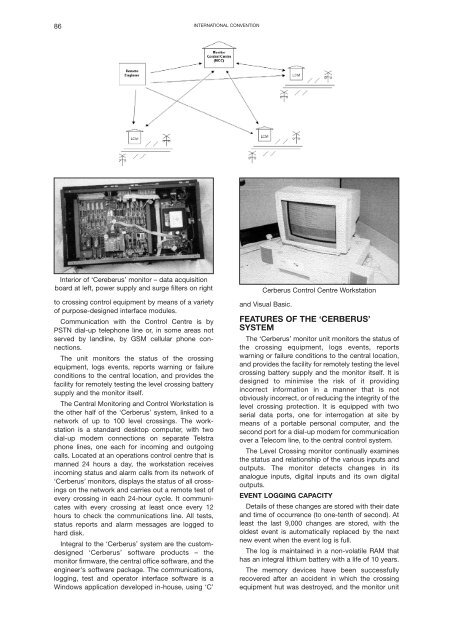Proceedings 2002/2003 - IRSE
Proceedings 2002/2003 - IRSE
Proceedings 2002/2003 - IRSE
You also want an ePaper? Increase the reach of your titles
YUMPU automatically turns print PDFs into web optimized ePapers that Google loves.
86<br />
INTERNATIONAL CONVENTION<br />
Interior of ‘Cereberus’ monitor – data acquisition<br />
board at left, power supply and surge filters on right<br />
to crossing control equipment by means of a variety<br />
of purpose-designed interface modules.<br />
Communication with the Control Centre is by<br />
PSTN dial-up telephone line or, in some areas not<br />
served by landline, by GSM cellular phone connections.<br />
The unit monitors the status of the crossing<br />
equipment, logs events, reports warning or failure<br />
conditions to the central location, and provides the<br />
facility for remotely testing the level crossing battery<br />
supply and the monitor itself.<br />
The Central Monitoring and Control Workstation is<br />
the other half of the ‘Cerberus’ system, linked to a<br />
network of up to 100 level crossings. The workstation<br />
is a standard desktop computer, with two<br />
dial-up modem connections on separate Telstra<br />
phone lines, one each for incoming and outgoing<br />
calls. Located at an operations control centre that is<br />
manned 24 hours a day, the workstation receives<br />
incoming status and alarm calls from its network of<br />
‘Cerberus’ monitors, displays the status of all crossings<br />
on the network and carries out a remote test of<br />
every crossing in each 24-hour cycle. It communicates<br />
with every crossing at least once every 12<br />
hours to check the communications line. All tests,<br />
status reports and alarm messages are logged to<br />
hard disk.<br />
Integral to the ‘Cerberus’ system are the customdesigned<br />
‘Cerberus’ software products – the<br />
monitor firmware, the central office software, and the<br />
engineer's software package. The communications,<br />
logging, test and operator interface software is a<br />
Windows application developed in-house, using ‘C’<br />
Cerberus Control Centre Workstation<br />
and Visual Basic.<br />
FEATURES OF THE ‘CERBERUS’<br />
SYSTEM<br />
The ‘Cerberus’ monitor unit monitors the status of<br />
the crossing equipment, logs events, reports<br />
warning or failure conditions to the central location,<br />
and provides the facility for remotely testing the level<br />
crossing battery supply and the monitor itself. It is<br />
designed to minimise the risk of it providing<br />
incorrect information in a manner that is not<br />
obviously incorrect, or of reducing the integrity of the<br />
level crossing protection. It is equipped with two<br />
serial data ports, one for interrogation at site by<br />
means of a portable personal computer, and the<br />
second port for a dial-up modem for communication<br />
over a Telecom line, to the central control system.<br />
The Level Crossing monitor continually examines<br />
the status and relationship of the various inputs and<br />
outputs. The monitor detects changes in its<br />
analogue inputs, digital inputs and its own digital<br />
outputs.<br />
EVENT LOGGING CAPACITY<br />
Details of these changes are stored with their date<br />
and time of occurrence (to one-tenth of second). At<br />
least the last 9,000 changes are stored, with the<br />
oldest event is automatically replaced by the next<br />
new event when the event log is full.<br />
The log is maintained in a non-volatile RAM that<br />
has an integral lithium battery with a life of 10 years.<br />
The memory devices have been successfully<br />
recovered after an accident in which the crossing<br />
equipment hut was destroyed, and the monitor unit

















